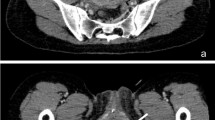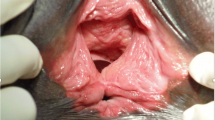Abstract
The aims of this study were to compare the pre- and postoperative urodynamic findings of the suburethral autologous rectus fascial sling procedure and to determine patient satisfaction with the procedure by telephone interviews. Eight-four female patients with urodynamic stress incontinence completed a multi-channel urodynamic study and pad test before and after the operation. Subjective and objective satisfaction were also recorded. Significant changes were noted in the stress maximal urethral closure pressure, pad test, voided volume, and peak flow rate (P < 0.05). The success rate was about 94%, and subjective satisfaction was about 72%. The most common complication was transient urinary tract infections. The suburethral sling resolved 50% of detrusor overactivity (DO), but de novo DO was 24%. The procedure combined with anterior colporrhaphy corrected or improved 97% of anterior vaginal wall prolapses (≥stage II). This retrospective study demonstrates that suburethral autologous facial slingplasty has a high cure rate, high patient satisfaction, and is a less complicated procedure. It can also correct and prevent a recurrence of anterior vaginal wall prolapse when combined with anterior colporrhaphy.

Similar content being viewed by others
References
Ulmsten U, Petros P (1995) Intravaginal slingplasty (IVS): an ambulatory surgical procedure for treatment of female urinary incontinence. Scand J Urol Nephrol 29:75–82
DeLancey JOL (1994) Structural support of the urethra as it relates to stress urinary incontinence: the hammock hypothesis. Am J Obstet Gynecol 170:1713–1720
Albo ME, Richter HE, Brubaker L, Norton P, Kraus SR, Zimmern PE (2007) Burch colposuspension versus fascial sling to reduce urinary stress incontinence. N Engl J Med 356(21):2143–2155 May 24
Morgan DM, Dunn RL, Fenner DE, Faerber G, DeLancey JO, McGuire EJ (2007) Comparative analysis of urinary incontinence severity after autologous fascia pubovaginal sling, pubovaginal sling and tension-free vaginal tape. J Urol 177(2):604–608 Feb
Simsiman AJ, Powell CR, Stratford RR, Menefee SA (2005) Suburethral sling materials: best outcome with autologous tissue. Am J Obstet Gynecol 193:2112–2116
Bezerra CA, Bruschini H (2001) Suburethral sling operations for urinary incontinence in women. Cochrane Database Syst Rev:CD001754
Howden NS, Zyczynski HM, Moalli PA, Sagan ER, Meyn LA, Weber AM (2006) Comparison of autologous rectus fascia and cadaveric fascia in pubovaginal sling continence outcomes. Am J Obstet Gynecol 194:1444–1449
Hilton P (1989) A clinical and urodynamic study comparing the Stamey bladder neck suspension and suburethral sling procedures in the treatment of genuine stress incontinence. Br J Obstet Gynaecol 96:213–220
Abdel-Fattah M, Sivanesan K, Ramsay I, Pringle S, Bjornsson S (2006) How common are tape erosions? A comparison of two versions of the transobturator tension-free vaginal tape procedure. BJU Int 98(3):594–598
Domingo S, Alamá P, Ruiz N, Lázaro G, Morell M, Pellicer A (2007) Transobturator tape procedure outcome: a clinical and quality of life analysis of a 1-year follow-up. Int Urogynecol J Pelvic Floor Dysfunct 18(8):895–900
Abrams P, Blaivas JG, Stanton SL, Andersen JT (1988) The standardisation of terminology of lower urinary tract function. The International Continence Society Committee on Standardisation of Terminology. Scand J Urol Nephrol Suppl 114:5–19
Ng S, Tee YT, Tsui KP, Chen GD (2007) Is the role of Burch colposuspension fading away in this epoch for treating female urinary incontinence? Int Urogynecol J Pelvic Floor Dysfunct 18:937–942
Tsui KP, Ng SC, Yeh GP, Hsieh PC, Lin LY, Chen GD (2006) Changes of urethral pressure profilometry in pubovaginal sling and modified Burch colposuspension procedures. Taiwan J Obstet Gynecol 45:129–134
Weinberger MW, Ostergard DR (1995) Long-term clinical and urodynamic evaluation of the polytetrafluoroethylene suburethral sling for treatment of genuine stress incontinence. Obstet Gynecol 86:92–96
Chaikin DC, Rosenthal J, Blaivas JG (1998) Pubovaginal fascial sling for all types of stress urinary incontinence: long-term analysis. J Urol 160:1312–1316
Jensen JK, Rufford HJ (2001) Sling procedure-artificial. In: Cardozo L, Staskin DR, (eds) Textbook of Female Urology and Urogynaecology. Taylor & Francis, New York, pp 543–562
Guerrero K, Watkins A, Emry S, Wareham K, Stephenson T, Logan V (2007) A randomized controlled trial comparing two autologous fascial sling techniques for the treatment of stress urinary incontinence in women: short, medium and long-term follow-up. Int Urogynecol J 18:1263–1270
Muller SC, Steinbach F, Maurer FM, Melchior SW (1993) Long-term results of fascial sling procedure. Int Urogynecol J Pelvic Floor Dysfunct 4:199–203
Latini JM, Lux MM, Kreder KJ (2004) Efficacy and morbidity of autologous fascia lata sling cystourethropexy. J Urol 171:1180–1184
Cholhan HJ, Lotze PM (2004) Voiding function after a modified no-tension pubovaginal sling. Int Urogynecol J Pelvic Floor Dysfunct 15:249–256
Botros SM, Abramov Y, Goldberg RP, Beaumont JL, Gandhi S, Miller JJ, Sand PK (2005) Following midurethral versus bladder sling procedures. Am J Obstet Gynecol 193:2144–2148
Botros SM, Miller JJ, Goldberg RP, Gandhi S, Akl M, Beaumont JL, Sand PK (2007) Detrusor overactivity and urge urinary incontinence following trans obturator versus midurethral slings. Neurourol Urodyn 26(1):42–45
Cardozo LD, Stanton SL, Williams JE (1979) Detrusor instability following surgery for genuine stress incontinence. Br J Urol 51:204–207
Frederick RW, Leach GE (2005) Cadaveric prolapse repair with sling: intermediated outcomes with 6 months to 5 years of follow up. J Urol 173:1229–1233
Conflict of interest statement
None.
Author information
Authors and Affiliations
Corresponding author
Rights and permissions
About this article
Cite this article
Tsui, KP., Ng, SC., Yeh, GP. et al. Outcomes of autologous fascial slingplasty procedure for treating female urinary incontinence. Int Urogynecol J 19, 949–954 (2008). https://doi.org/10.1007/s00192-008-0569-z
Received:
Accepted:
Published:
Issue Date:
DOI: https://doi.org/10.1007/s00192-008-0569-z




